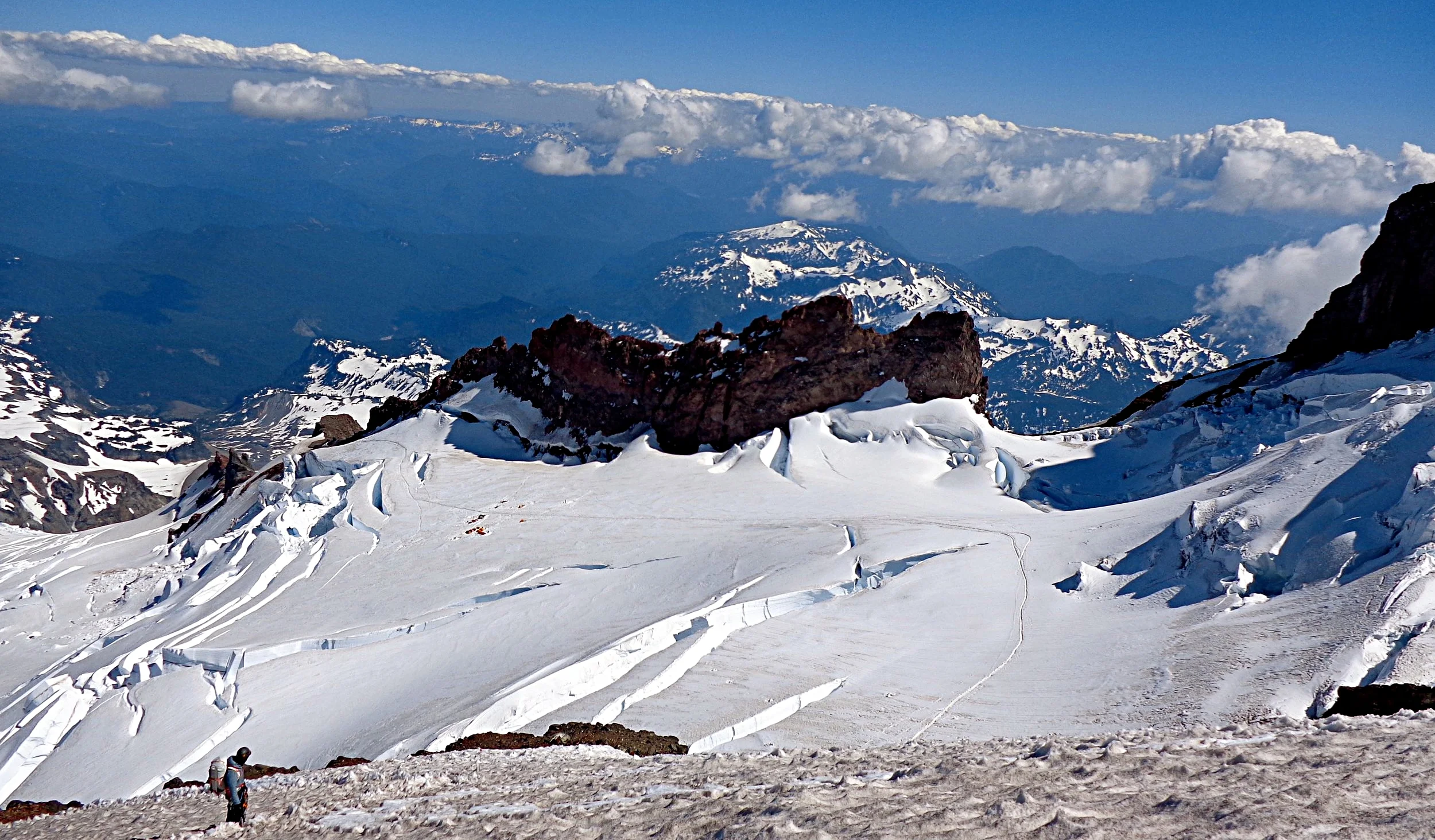Ingram Flats. Photo: Toby Nitzsche.
What I knew about Glacier Science before this trip was nothing. I knew there was snow… and ice, and that glaciers traveled slowly down mountain faces carving valleys and cirques and other geological and topographical features. I know that many of the snow features we had once classified in Colorado as glaciers were reclassified at some point as “Slow Moving Snow Fields.”
What I knew more about before the trip to rainier,
at least in theory, was glacier travel, self/ crevasse rescue and partner rope rescue. I’ll admit, I’m no expert but having been on the Rocky Mountain Rescue group for the last 17 years, I felt proficient in my knowledge and confident that if I spent some time practicing, I’d be prepared for most of the common and some of the uncommon accidents that can occur during glacier travel.
Although at times some of the precautions seem like more than are necessary, you never know when snow and ice melt will give way to crevasse formation underneath you. Glaciers are ever moving things, and “the whole” glacier, if you want to think of it that way, doesn’t move at the same rate all over the place. Crevasses are generally formed in what are called tension zones where fast moving ice pulls away from slow moving ice. Often times, tension zones are formed over steeper sections of the mountain, while compression zones above or below are formed on flatter sections. Every feature of the mountain itself creates tension within the ice flow. There are “margin” forming crevasses created by slower moving ice next to faster moving ice. Dramatic turns in the rock far beneath the glacier can also make the ice flow turn and pull away from itself, creating crevasses known as “radial” crevasses. “Longitudinal” crevasses are caused by ice from the glacier spilling into large valleys or plains where it spreads out laterally. Finally a Bergschrund is a gap that’s formed from heavy, slow moving ice pulling away from more stable ice above it. Often the feature of ice and rock above the Bergschrund is steep and stable ice that isn’t developing enough real weight to pull away from the wall. The snow that falls on sections like this generally doesn’t stick; it sloughs off onto the glacier below making it heavier and more susceptible to pulling away from the steeper section.
(Graphic) www.glaciers.pdx.edu
Crevasses
Crevasses can be feet deep or hundreds of feet deep and can open up into other crevasses, ice caves, flowing water or any number of features problematic in the least to the glacier traveler. In fact, at about 12,000 feet on our 3rd day of our expedition 2 naked, and I mean naked, skiers passed us coming down the mountain. I try not to judge other mountaineers. I can be envious sometimes of others skill levels, goals, accomplishments and their willingness to take on certain risks I wouldn’t. Mountaineering is as much about personal prioritization as it is accomplishment, and we all want different things from life in general. In my personal philosophy, if you’re not outright putting others in danger, you understand the consequences of your choices, then you should have the freedom to challenge yourself physically, mentally and in all other ways against a mountain. To me, this kind of decision making is more complicated than I’ve just illustrated, but for now, and for everyone who’s not me or my climbing partner, I’ll leave it at that. 3 days after we completed Rainier, on July 4th, 2017, While I was back at home, after our trip, I read a news story of a skier who fell into a crevasse while skiing over a snow-bridge. His body was found a month later at the toe of the glacier, washed out by an underground stream of water well below the surface from where he’d fallen.
Glacier travel and ice climbing require an understanding of and familiarity with climbing gear like ropes, harnesses, crampons, ice axes, rappelling and ascension equipment, and rope hauling equipment. Although that’s not an exhaustive list, it can be easy to take for granted these important tools when you’re traveling across flat, snowy terrain.
